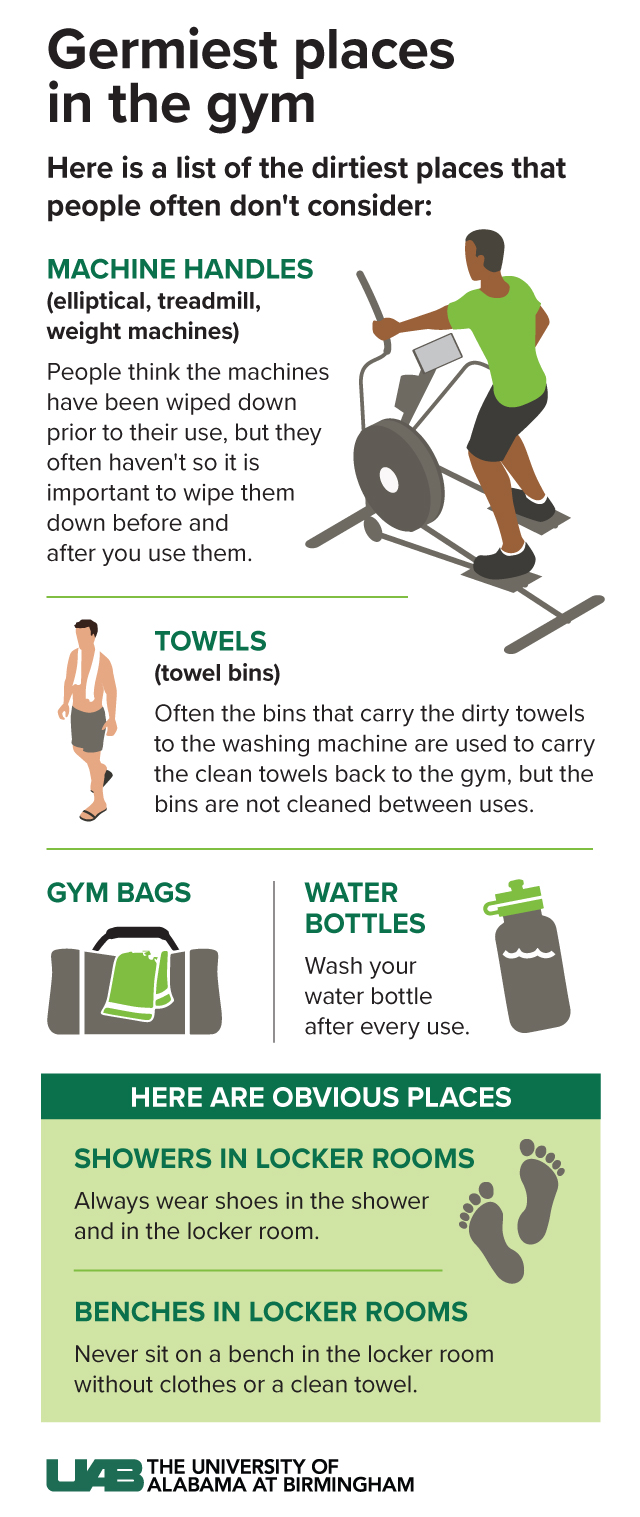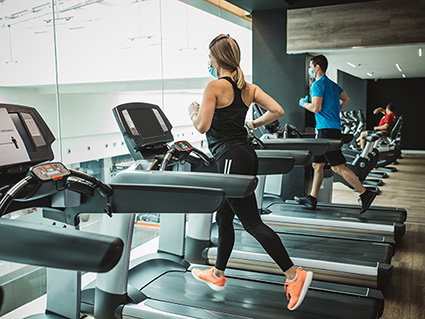Editor's Note: The information published in this story is accurate at the time of publication. Always refer to uab.edu/uabunited for UAB's current guidelines and recommendations relating to COVID-19.
 Now that states are reopening, many gyms and fitness studios are also reopening their doors. But if you choose to go to one, will you be protected from the novel coronavirus? Between shared equipment, heavy breathing and sweating, and the proximity of machines, a gym may be one of the dirtiest places you can walk into. Numerous studies have shown that gyms can be covered in cold and flu viruses, as well as E. coli, MRSA, and other bacteria and virus strains that can make you sick.
Now that states are reopening, many gyms and fitness studios are also reopening their doors. But if you choose to go to one, will you be protected from the novel coronavirus? Between shared equipment, heavy breathing and sweating, and the proximity of machines, a gym may be one of the dirtiest places you can walk into. Numerous studies have shown that gyms can be covered in cold and flu viruses, as well as E. coli, MRSA, and other bacteria and virus strains that can make you sick.
Bryan Combs, Ph.D., a nurse practitioner at the University of Alabama at Birmingham School of Nursing, explains the safest way to work out, how to protect yourself from the novel coronavirus while exercising in indoor, communal spaces and the dirtiest places in the gym.
How to work out at home
According to Combs, the best place to work out right now is at home.
“I would recommend people do everything they possibly can to exercise at home. If you have the space and equipment, your home is the safest place right now,” Combs said. “If you can work out from home, but don’t have the equipment, there are several ways to exercise in your own space and make use of household items you have on hand.”
Combs recommends the following to continue to work out from home:
- Walk, run or ride your bike outside
- Watch online workout classes and/or videos
- If you do not have weights, do body weight exercises, or use gallon jugs or buckets filled with water
If you cannot workout from home and want to go to the gym or an exercise class, you should understand that you are going at your own risk and may be exposed to others who may be infected with the novel coronavirus. Here is what Combs recommends doing at the gym if you decide to go:
How to lower your risk of contracting COVID-19 while working out in gyms
Go during an off hour
If your schedule permits, try to go to the gym at a time of day that is less crowded, such as early morning, late morning or later in the evening.
Bring your own hand sanitizer, antibacterial wipes and towel
Use hand sanitizer before and after you touch doorknobs, door handles, machines and weights. While many gyms may provide antibacterial spray or wipes to use on the equipment, it is best to bring your own wipes to clean these items before and after you use them.
As Combs referenced above, bring your own towel, and try to avoid wiping your eyes, mouth and nose with it. You should also keep it in your gym bag and use it only when you need it — do not let it rest on equipment while you exercise.
Wear your mask
Wear your mask while you exercise. People will be breathing heavily, sweating and likely coughing as they work out. Wear your mask to avoid spreading your germs to others, and try to avoid machines or areas that are close to people who are not wearing their own face coverings.
“If you choose to work out at a gym, you should always wear your face mask, and I would avoid going to a gym that allows any person to not wear their own face masks,” Combs said.
Use cardio machines and universal weight systems
“I would recommend using cardio equipment like treadmills or elliptical machines, and cleaning them with an antibacterial wipe before and after you use them.”
If you want to lift weights, use universal systems like weight machines as opposed to free weights.
“Universal weight systems allow you to do various exercises that target different muscle groups from the same machine, which will reduce the number of items you touch.”
Wear gloves while handling weights and other equipment
Wear gloves while you use shared equipment, and then store them in your gym bag in a sealed plastic bag so they do not contaminate your other belongings, such as your cellphone, car keys and water bottle.
Keep your distance
Gyms and fitness studios should be following social distancing practices and spacing out machines, mats and equipment. If you can, try to work out in an area that is less crowded, and avoid using machines that are close together. You should continue to keep 6 feet between yourself and other patrons.
Skip the bathroom and locker room
If you can, avoid using a public restroom or the locker room. Wait to shower and change until you get home, as people in these spaces will likely not be wearing masks and will be in close contact with one another.
Dirtiest places in the gym
“The biggest thing about the gym is there are a lot of areas where germs, viruses and fungus can be year-round,” Combs explained.
Here are the top places:
Handlebars
The worst places are handlebars on ellipticals, treadmills, stationary bicycles and weight machines.
“Even if the handlebars are cleaned regularly, handlebars are going to be covered in bacteria,” Combs said.
On top of that, many people assume the machines have been cleaned after each use; but that is often not the case. It is best to clean the machines on your own before and after each use.
“You need to use wipes or a disinfectant spray to wipe down the machines or weights before and after. Once you clean the equipment, hang your towel on an area that you know is clean. When you get done, clean it again for the next person.”
Towels
Something that people incorrectly assume is clean is the towels that gym patrons grab when they walk into the facility.
“While the towels have been washed, a lot of gyms use the same container to carry dirty towels to the washing area that they use to bring clean towels back, so they can become contaminated again.”
Combs recommends bringing your own clean towel to make sure you avoid contamination with the germs from dirty towels. It is important to always wash your towel after each workout, too.
 The safest place to exercise is at home or outside; but if you must go to the gym, follow these steps.Water bottles
The safest place to exercise is at home or outside; but if you must go to the gym, follow these steps.Water bottles
While using reusable water bottles is recommended and good for the environment, it is important to always wash them after every use.
“Some people use the same water bottle each time they go to the gym. If you don’t take it home and wash it, and you go to the gym a few or several days a week, the water bottle could be covered in bacteria.”
Combs says soap and hot water are the best ways to wash the bottles after each visit to the gym.
Gym bags
Gym bags are often the most overlooked items and often carry the most bacteria.
“A lot of times, we take our dirty clothes and put them in there; but we never clean the bag when we are done.”
To prevent the spread of germs, it is important to always spray the bags with a disinfectant spray to kill the bacteria. This is recommended after each use if possible, but at least a few times a week for frequent gym-goers.
Showers and locker rooms
While you should try to avoid public restrooms and locker rooms right now, if you must use one, Combs says to always wear shoes in all areas of the gym, but especially in locker rooms and in the shower. If you sit down, make sure a clean towel is placed on top of the bench or seat.
“Walking barefoot in locker rooms or showers is an easy way to contract MRSA or pick up a fungal infection like athlete’s foot. By wearing clean shoes, you can prevent catching something that is spread by skin contact.”
It is also important to change your clothes after each workout.
“As soon as you leave the gym, you should change clothes as soon as possible. A lot of people continue to wear their sweaty clothes for an hour or hour and a half. It’s important to take those off and shower as soon as you can after a workout.”
While most people know that door handles, bathroom knobs and faucets may be contaminated, it is important to use paper towels to turn off faucets and open the door after washing your hands.
For more information about the novel coronavirus, visit www.uab.edu/coronavirus.
